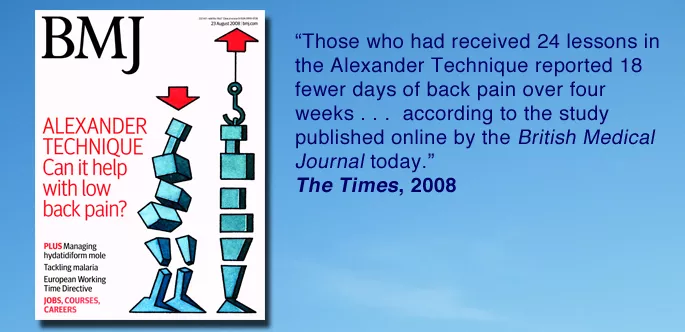Why the Alexander Technique Is Recommended for People with Postural Pain
The Alexander Technique is often recommended for people suffering from postural pain because it addresses the root causes of discomfort, rather than just the symptoms. Here’s why it can be especially effective:
- Improves Body Awareness:
Many people with postural pain aren’t aware of how their everyday habits—like slouching, craning the neck, or locking the knees—affect their bodies. The Alexander Technique teaches individuals to become more conscious of their posture and movement patterns, allowing them to identify and change habits that contribute to pain.
- Encourages Natural Alignment:
Instead of imposing a rigid “correct” posture, the technique helps the body return to a more natural, balanced alignment. This reduces unnecessary tension and strain on muscles and joints, which is often the source of chronic postural pain.
- Retrains Harmful Movement Patterns:
Over time, repeated poor movement patterns can cause or exacerbate postural issues. The Alexander Technique gently re-educates the body to move more efficiently and with less effort—reducing wear and tear on the body and easing pain.
- Reduces Muscle Tension and Stress:
By promoting relaxation and minimizing overuse of certain muscle groups, the technique helps reduce chronic tension—particularly in the neck, shoulders, and lower back. This often leads to a noticeable reduction in postural discomfort.
- Supports Long-Term Relief, Not Quick Fixes:
Unlike temporary solutions like braces or massages, the Alexander Technique empowers people with long-term strategies for managing and preventing pain. It fosters independence and self-care by teaching sustainable, body-friendly habits.
- Validated by Research:
Studies, including research published in the British Medical Journal, have shown that the Alexander Technique can significantly reduce chronic back and neck pain and improve quality of life.
Benefits of the Alexander Technique for Postural Pain
- Relief from chronic back, neck, and shoulder pain:
Many postural issues stem from unconscious habits—like tensing the neck when using a phone or slumping at a desk. The Alexander Technique helps you recognize and change these automatic reactions, reducing strain and discomfort over time.
- Improved balance and coordination:
By bringing awareness to how you move during everyday activities, walking, standing, sitting—the technique retrains habitual movement patterns, restoring natural balance and poise.
- Reduced muscle tension and stress:
Common stress reactions, such as tightening the jaw, raising the shoulders, or holding the breath, often go unnoticed. The Alexander Technique teaches you to pause and respond more consciously, easing tension and promoting a calmer, more relaxed state.
Step-by-Step: How a Lesson Works
- Gentle hands-on guidance:
The teacher uses light, non-invasive touch to help you become aware of subtle patterns of tension and misalignment. This physical guidance encourages more easeful, balanced movement during simple activities like sitting, standing, or walking.
- Breathing and movement awareness:
You’ll learn to notice how habitual reactions—such as shallow breathing or holding tension when moving—affect your posture and comfort. With gentle verbal cues and practice, you’ll begin to restore natural coordination between breath and movement.
- Releasing unnecessary tension:
Much of the lesson focuses on helping you recognize and stop unconscious habits that lead to excess effort—whether you’re typing at a desk, lifting a bag, or even just standing. The goal is not to impose a “correct” posture, but to allow freedom and lightness in movement.
Everyday Applications for Better Posture
Recognizing and changing unconscious habits of reaction in daily life
- Sitting at a desk:
Instead of forcing yourself to “sit up straight,” the Alexander Technique invites you to notice and pause before reacting—like tightening your neck, gripping the chair, or slumping when concentrating. By interrupting these habitual reactions, you allow more natural and supported sitting without added strain.
- Walking and standing:
Whether you’re rushing to catch a train or standing in line, you may react by stiffening your legs, holding your breath, or tightening your shoulders. The Technique helps you become aware of these patterns so you can respond with greater ease and coordination, rather than tension and effort.
- Using technology without strain:
Common reactions to screens—like jutting the head forward, collapsing the chest, or tensing the jaw—often go unnoticed. Through the Alexander Technique, you learn to pause before engaging, so you can use devices with less strain and more freedom of movement.
- Speaking with more confidence:
Many people unconsciously tighten their throat, hold their breath, or slump their posture when speaking or presenting. The Technique helps you recognize these habitual reactions and replace them with freer, more relaxed use of your voice and body—boosting both confidence and clarity.
Why Experts Recommend the Alexander Technique
- Medical research support:
Studies, including those published in respected medical journals, show the Alexander Technique effectively reduces chronic postural pain by helping patients recognize and change harmful habitual patterns of movement and tension.
- Endorsements from healthcare professionals:
Many doctors, physiotherapists, and occupational therapists recommend the Technique as a complementary approach because it empowers patients to take an active role in managing their posture and pain through awareness and conscious change.
- Long-term improvement vs. quick fixes:
Unlike treatments that mask symptoms or offer temporary relief, the Alexander Technique addresses the root causes of postural pain—habitual reactions and misuse of the body—leading to sustainable, long-lasting improvement.
Conclusion
The Alexander Technique offers powerful benefits for those suffering from postural pain by helping you become aware of—and change—unconscious habits of tension and movement. Through improved body awareness, reduced muscle strain, and more natural coordination, it promotes lasting relief and better overall well-being.
If you’re experiencing discomfort or want to move with greater ease, consider exploring Alexander Technique lessons. Learning to pause and rethink your habitual reactions can be a transformative step toward a healthier, pain-free life.


